Clothes are strictly gendered. In stores, some are marketed as only for men while others are marketed as exclusively for women. Clothes that are marketed as “unisex” are a rare sight in shops. Thus many consumers tend to imagine that men’s clothes always differ from women’s clothes. On top of that, there’s also a social stigma against wearing clothes that were designed for the other sex. This is why, when they go shopping, majority of consumers only browse the isles that are marked as intended for their gender, and they don’t even glance at the stuff that can be found at the other side of the store.
The reality is different. A lot of clothes are essentially unisex, because there simply is no real difference between men’s and women’s version, the only thing that varies being tags, placement in a store, and marketing. Sometimes male and female products also do not cost the same, which is how we get gender-based price discrimination aka the pink tax. That’s one more reason why shoppers would benefit from comparing things that can be found in men’s and women’s isle.
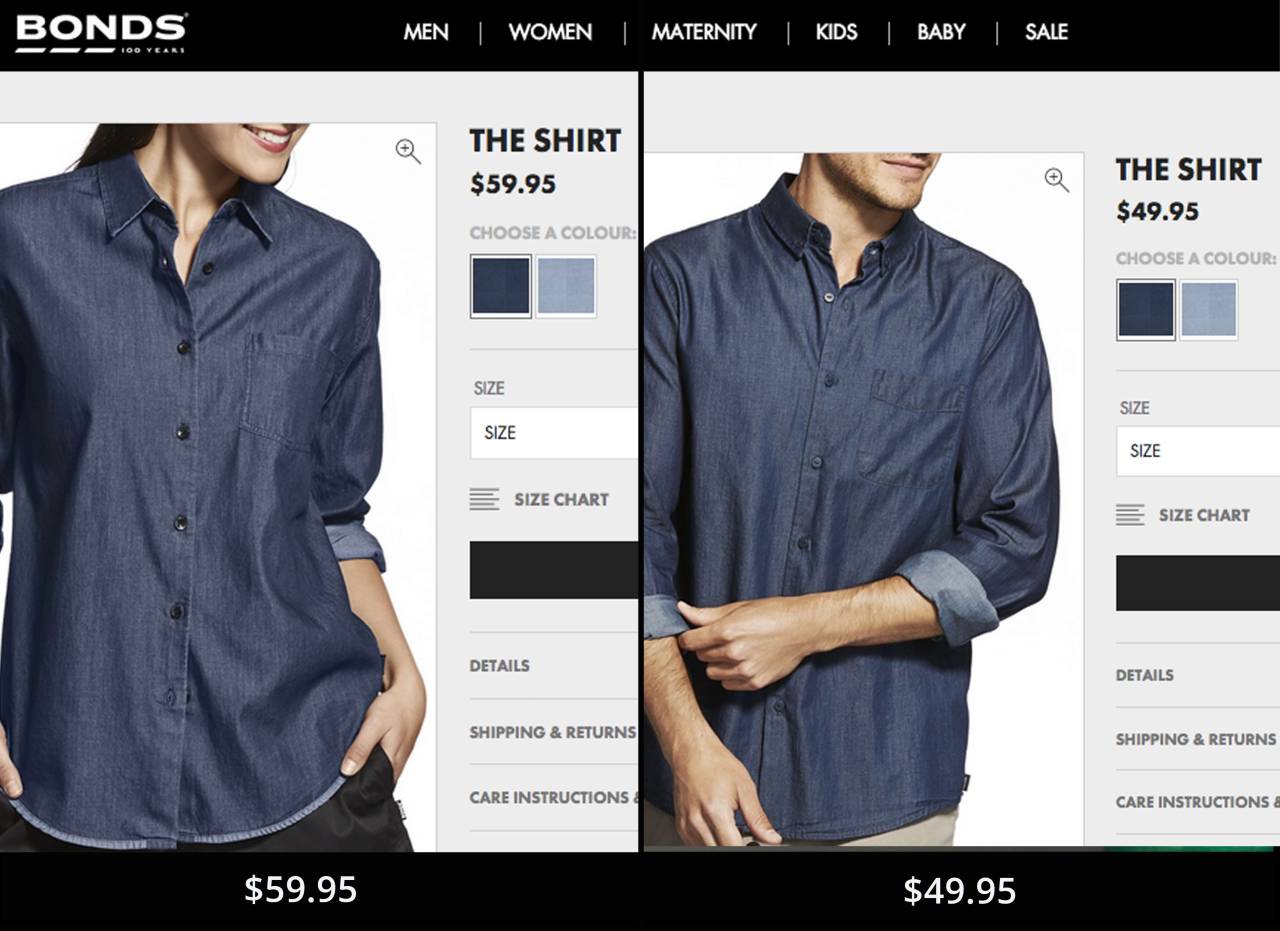
The pink tax in action.
The New York City Department of Consumer Affairs published an interesting study called From Cradle to Cane: The Cost of Being a Female Consumer, which compares the price of analogous products (from the same brand, in the same sizes, with the same active ingredients) marketed towards men and women. After comparing nearly 800 products (toys and accessories, children’s clothing, adult clothing, personal care products, and home health care products for seniors) researchers found out that, on average, women’s products cost 7 percent more than similar products for men. This means that women are paying thousands of dollars more over the course of their lives to purchase similar products as men. Often they are completely unaware about how they are getting ripped off.
Unnecessarily gendered products—often with different price tags for the men’s and women’s version—are a common sight in shops. Sometimes targeting some product exclusively at male or female shoppers makes sense. For example, most men don’t want to wear bras. It also makes sense to market menstrual pads to women given how trans men who might also need them are, statistically, a minority of the consumers interested in buying these products. And I am also fine with women’s underwear not having room for a penis. Thus, occasionally, marketing some product to only men or women makes sense.
The problem is that more often than not there is no good reason why some product should have a men’s and women’s version. Back when I was a child, everybody in my family used one and the same shampoo bottle. We also used the same bar of soap. Growing up, the first time I saw a TV commercial advertising separate shampoo “for him” and “for her,” I was puzzled. Why would men and women need different shampoo? We all have hair, and we all have to regularly wash it in order to keep it clean. Over the years, I didn’t pay close attention to the shifting shampoo placement in stores. Thus I was unpleasantly surprised when I suddenly realized that shampoo, soap, deodorants, etc. products are now placed on separate shelves for men and women.
I hope that I don’t need to explain to my readers why men and women don’t necessarily need different shampoo bottles, differently colored razors, and different food. This ought to be obvious, because for such products the main difference between men’s and women’s products is the packaging. Advertising uses color, shape, texture, verbiage, logos, graphics, sound, and names to define the gender of a brand. Lighter colors, smoother edges, flower motives, and softer lines are for ladies. Darker colors, harder lines, square or angular shapes, and science-related pictures are for men. Besides the packaging and marketing, often there is no real difference whatsoever in the product itself. It’s the same product with the same active ingredients. Thus people, mostly women, lose money for no good reason whatsoever simply by shopping in the women’s isle.
Clothing is where people expect to see real, tangible differences in the products themselves, not just their packaging and advertisements. Men’s and women’s clothing does differ. But only sometimes. In this article I will explain when and how male and female clothes differ and which clothes could be treated as unisex for practical purposes. I strongly believe that each person should be free to dress in any way they like, and marketing specialists shouldn’t impose any artificial restrictions on what’s allowed for each of us.
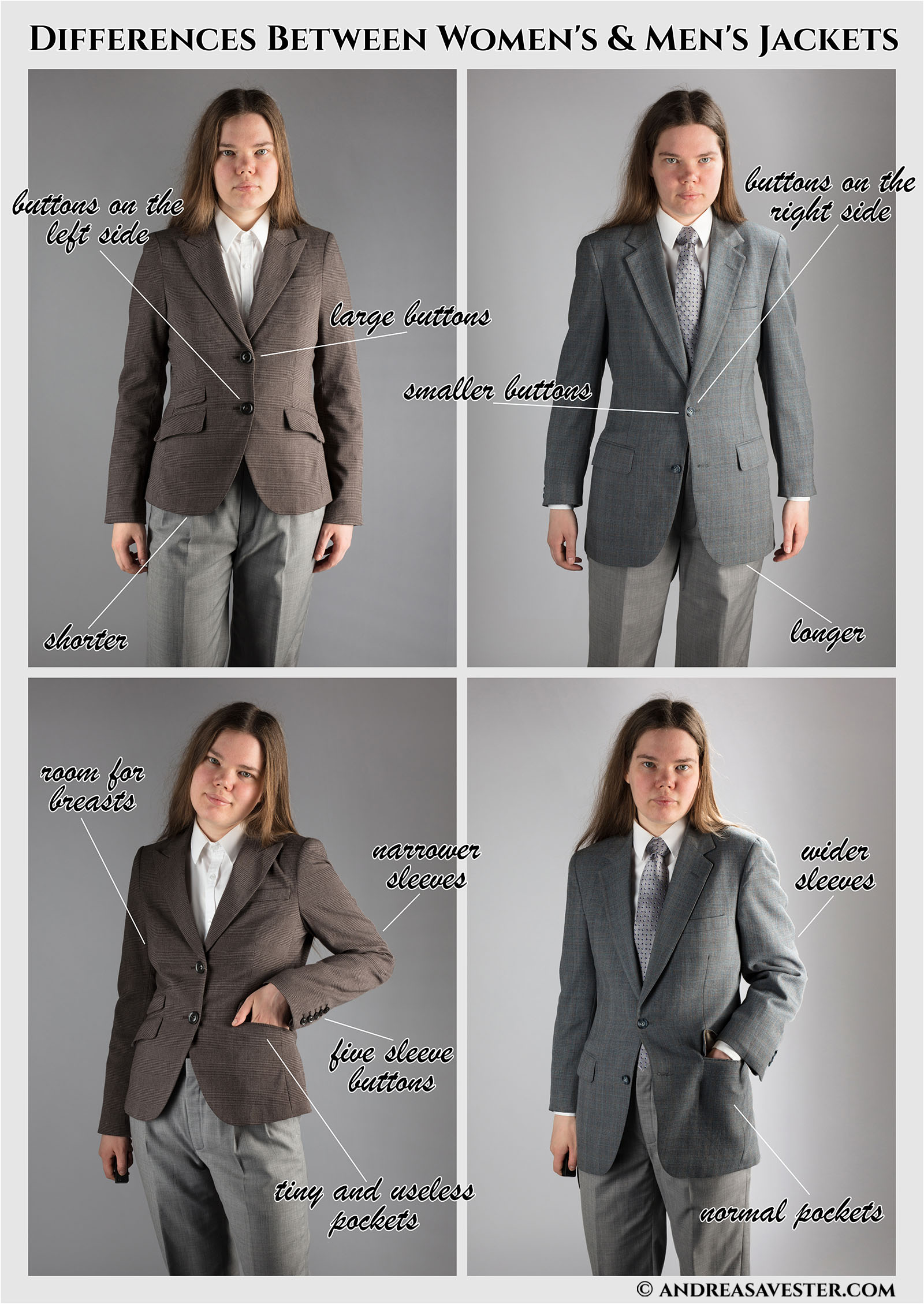
Differences between women’s and men’s jackets.
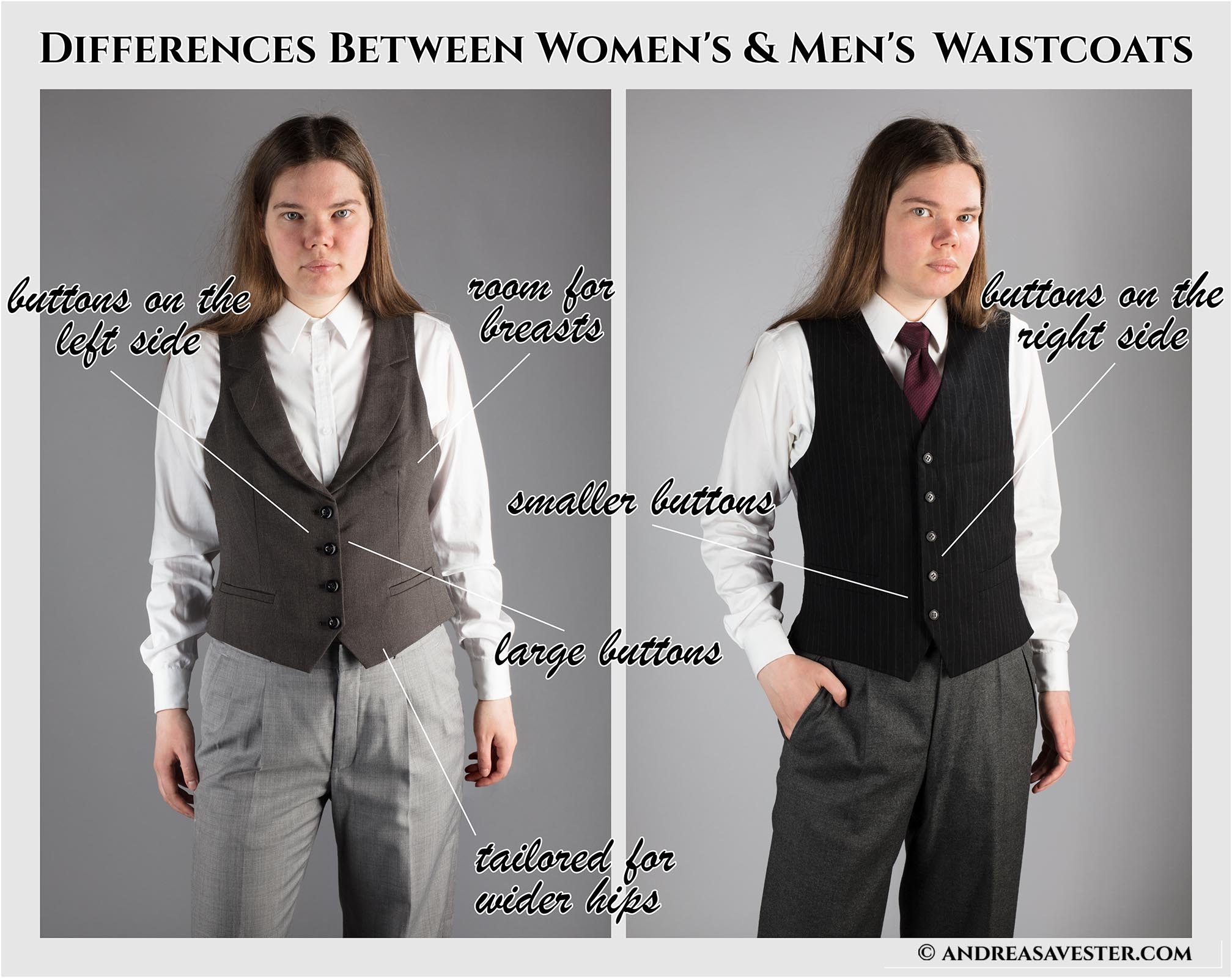
Differences between women’s and men’s waistcoats. In these photos, men’s waistcoat is worn with a binder that flattens my chest, women’s waistcoat is worn without it.
Here are some photos I made for the purpose of illustrating the differences between typical male and female jackets and waistcoats. They look visually different. If a woman used men’s shampoo at home, nobody would notice without visiting her and taking a look at her bathroom shelves. If she wore male clothing in public, some people would notice the difference. I say “some,” because I have been wearing male clothes for years, and my own mother still hasn’t figured it out. The thing is that while some male and female garments (like business jackets or waistcoats shown in these photos) do have significant visual differences, others look pretty much the same.
The general trend is that tailored and formal clothes are what differs the most. Athletic garments, clothing that isn’t tailored to tightly fit the wearer’s body, and clothing that doesn’t have any strict sizes at all usually doesn’t come in men’s and women’s versions with actual differences.
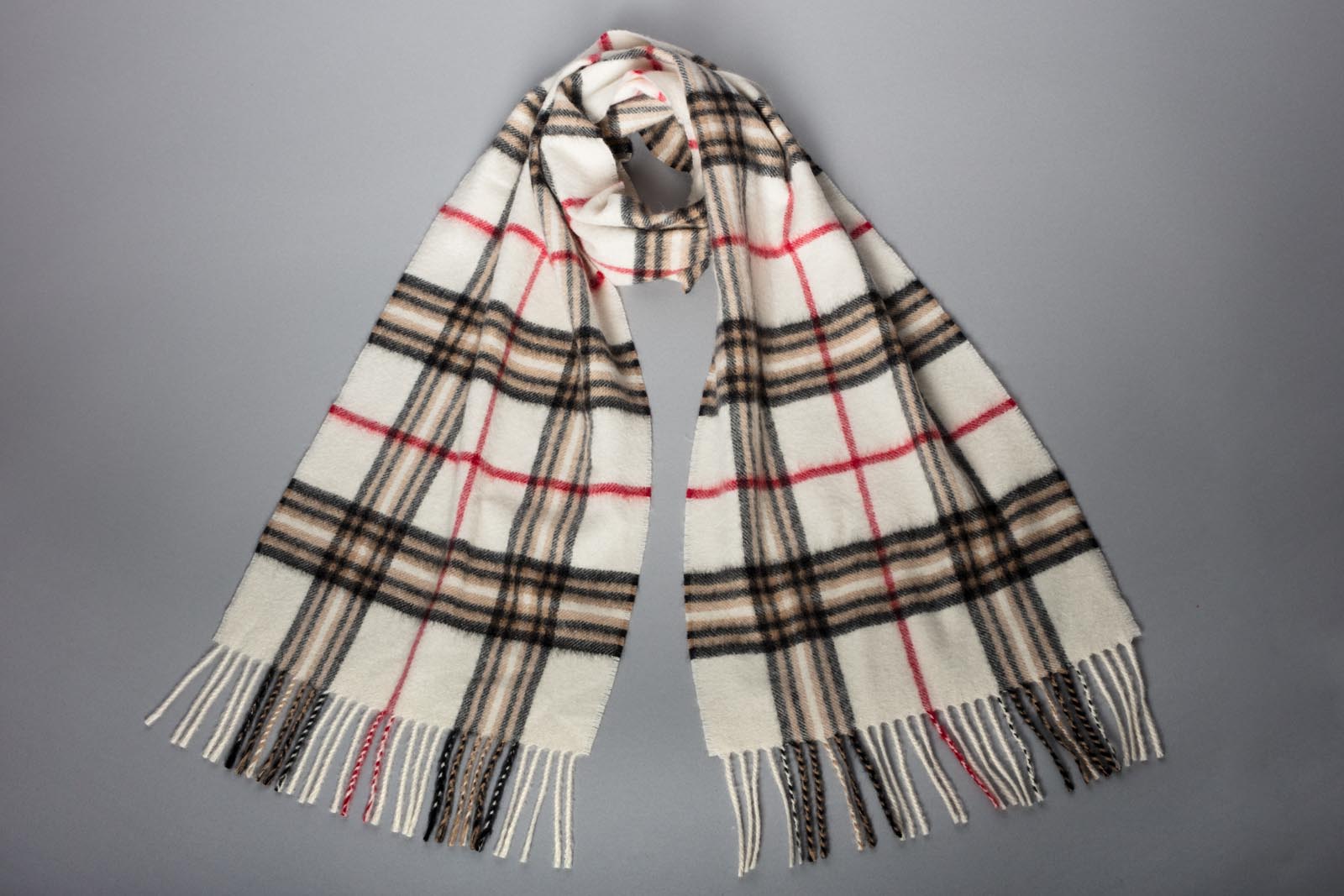
A scarf. Is it men’s or women’s?
Here’s a scarf I own. Is it men’s or women’s? I purchased it in Frankfurt, at the men’s section of a store. The catch is that at the same store they had another extremely similar scarf for women. Women’s version was the same color, same pattern, even approximately the same size. The only difference was that the men’s scarf was 100% cashmere. Women’s scarf was 100% acrylic. This time women’s scarf was cheaper, but, given the superior material, I consider men’s version the better deal.
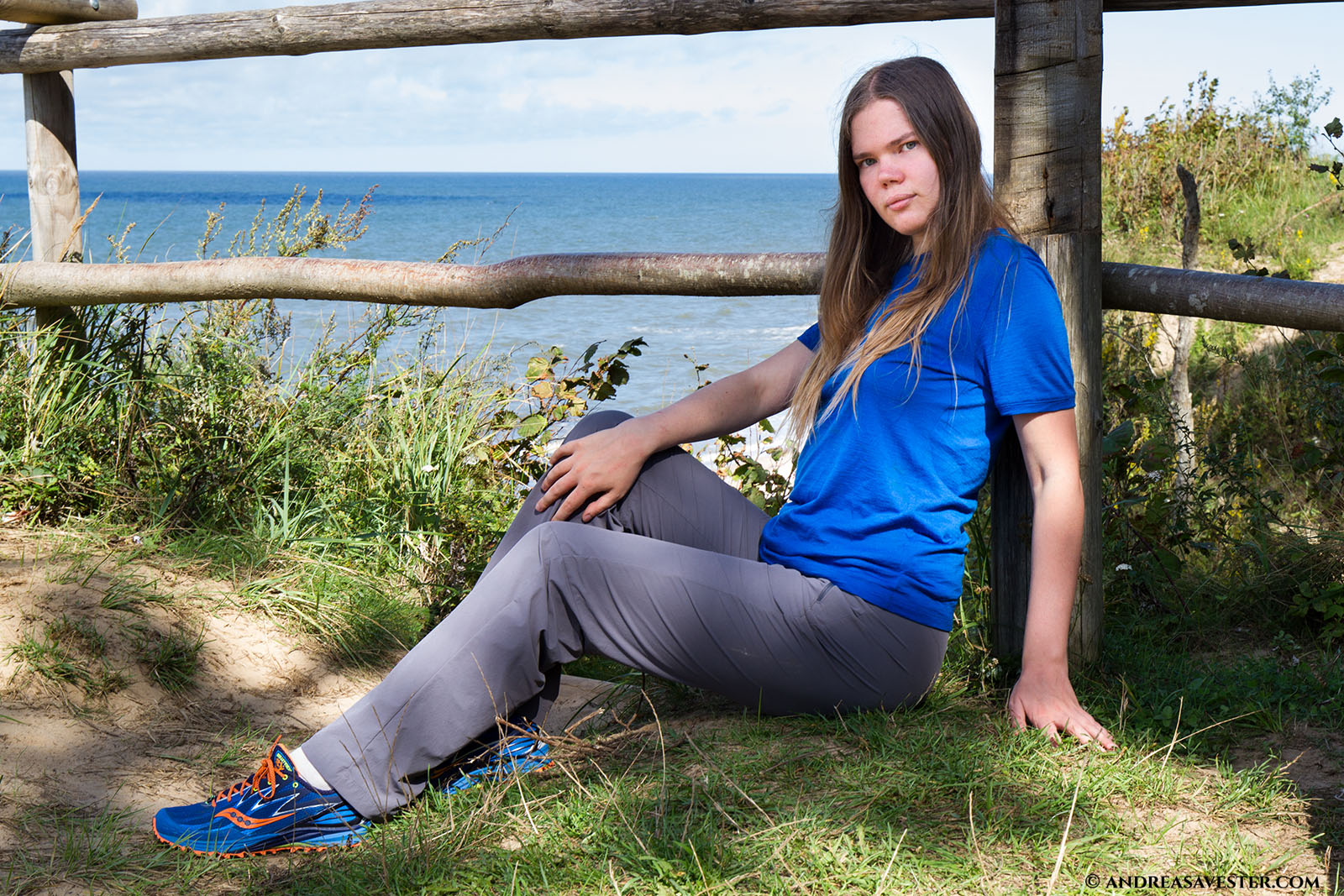
Do these look like male or female clothes?
Let’s try again. Can you tell whether I am wearing male or female clothing in this vacation photo? Here my T-shirt, pants, shoes, even socks are all purchased in men’s clothing stores. Could you tell that? Probably no. When it comes to more formal attire like business suits, there really are easily noticeable visual differences between male and female clothing, but when it comes to more casual or athletic garments, often they are pretty much the same. Men’s and women’s T-shirts are often identical. Running shoes, unless they are pink and covered with glitter, might as well be considered unisex. Never mind socks, which are, well, just socks.
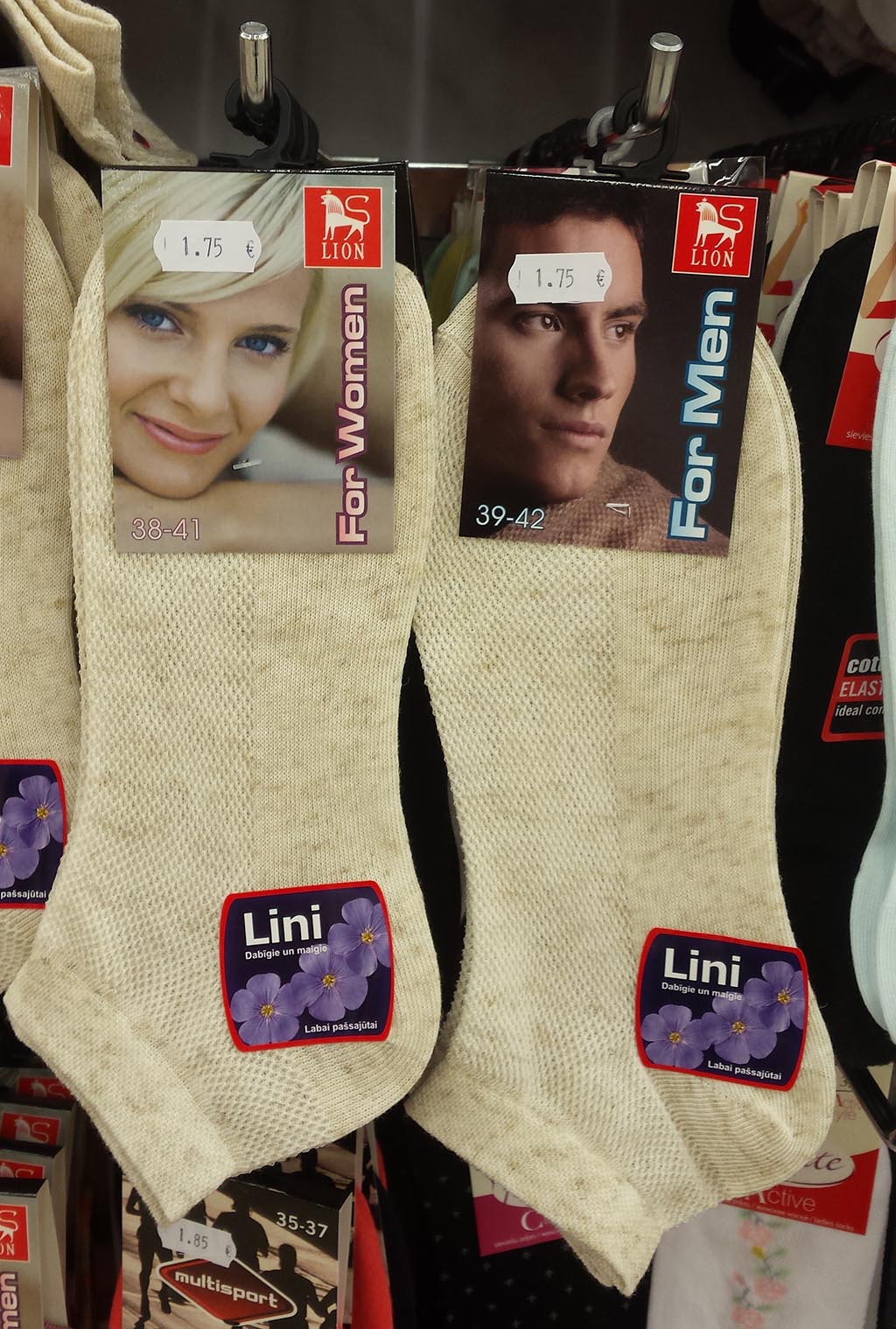
Identical socks, different packaging.
Here’s a photo I took in a store selling men’s and women’s socks. Kudos for the same price, but the packaging seems silly to me. Both pairs of socks are identical. They are made from the same material (linen and cotton blend), they look the same, they are identical (yes, I double checked). Why do people perceive socks as an item that must be gendered? Because of differences in shoe size? Well, there are some women with large feet just like there are some men with small feet, so this explanation doesn’t hold water. Obviously, the real reason are silly cultural expectations, which demand that male and female clothes must be strictly separated even when they are literally the same.
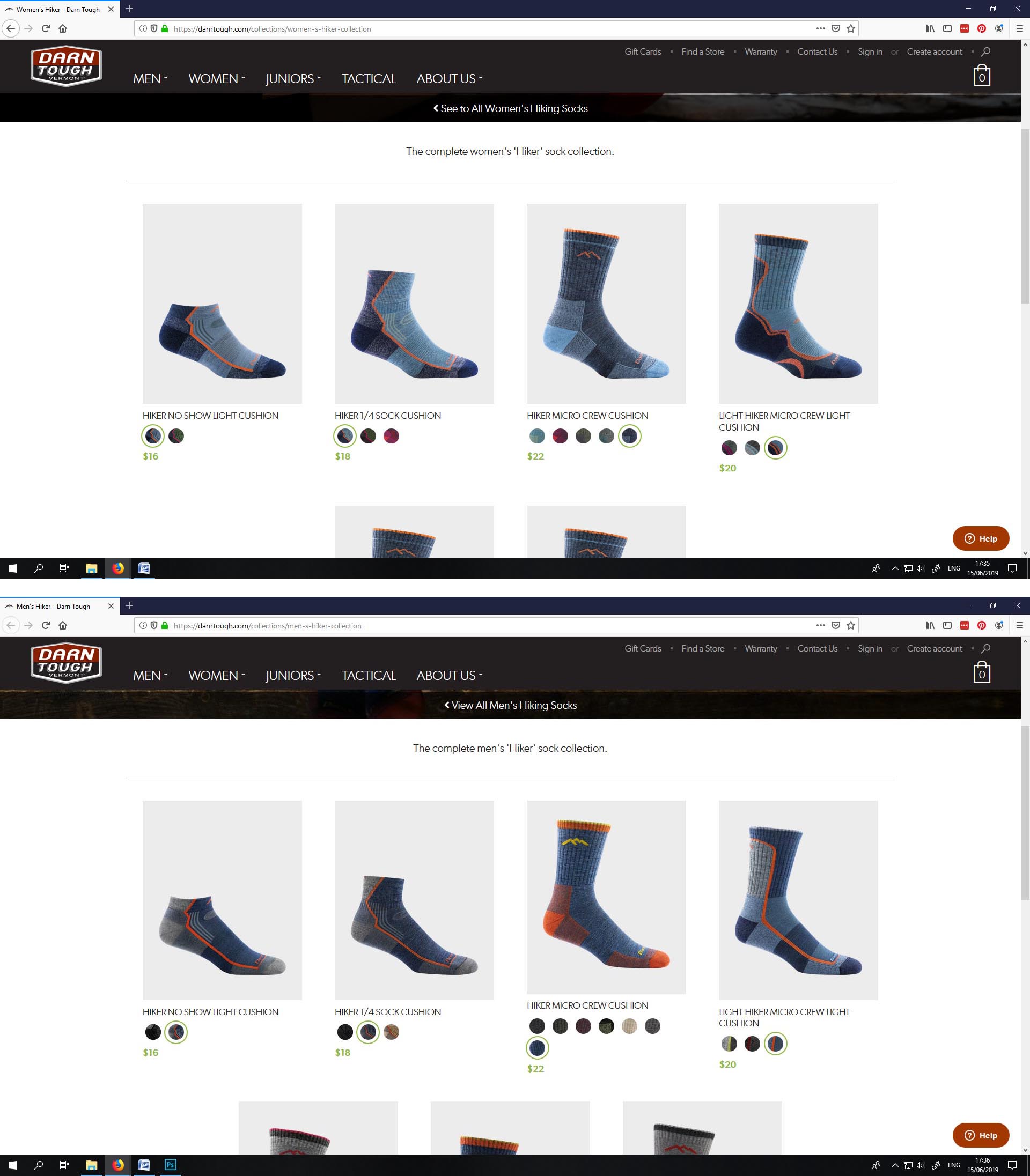
Women’s hiking socks versus men’s hiking socks. Now spot the difference!
Athletic socks are fun to analyze if you are in a mood for facepalming. Here are some hiking socks marketed towards men and women. Can you spot the differences between them? Yep, this time we have some minor palette swaps. This seller probably didn’t want to market an identical product to men and women, so they shoehorned some odd minor differences. Apparently, men need to wear hiking socks that are in a slightly different blue hue than the women’s version.

Gender neutral marketing. Apparently, this time anybody can wear this jacket.
I am happy to say that occasionally brands that sell athletic apparel do the sensible thing and clearly market their garments as unisex. Here’s an example of exactly that. Does this down jacket looks like something that both men and women can wear? Of course it does. Which is why it is marketed towards both male and female hikers and mountaineers.
My point is that sometimes male and female clothes are pretty much the same. This is why I can recommend people to check out the other range and see for themselves, maybe they will find something cheaper or better fitting or something that they like better among the garments marketed for the other sex.
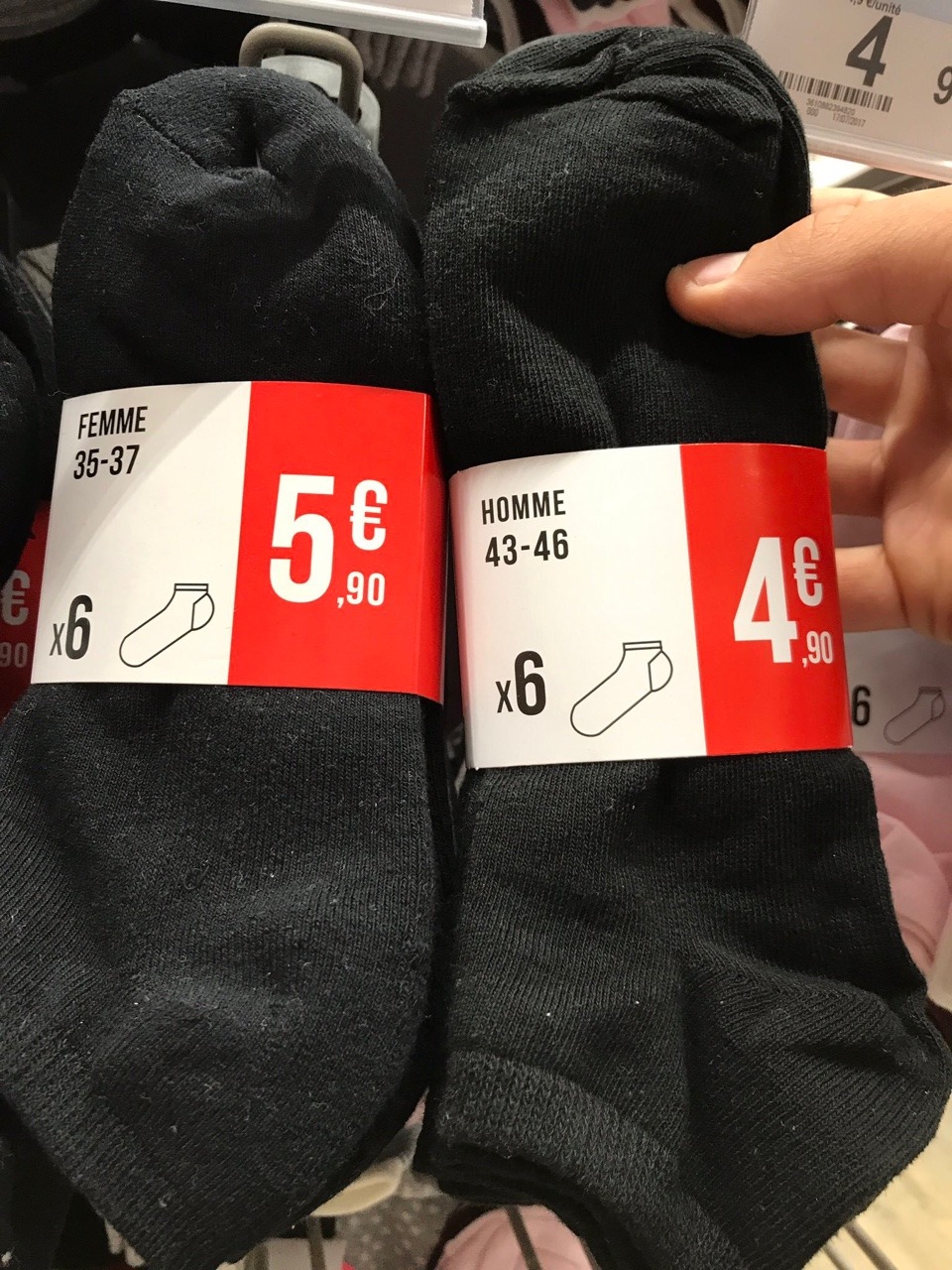
Are you kidding me! This time both products are literally the same. Why charge more for “women’s version”?
Assuming that your feet are large enough and you can find men’s socks that fit you, this time picking the men’s version of the product is the sensible thing to do regardless of whether you are male or female. Paying more just for the packaging is pointless when both products are literally identical.
Regardless of your gender identity or whether you prefer a masculine or feminine gender performance, in reality you have more options than you might imagine if until now you only looked at shop isles that were marketed as intended for your gender.
Speaking of clothing and shoes in general, I have gotten the impression that often men’s products are better made and more durable, they are also made from better materials. I only have anecdotal evidence to support this claim, but I do believe that it’s happening.
A few years ago, back when I wanted to buy business trousers, I combed multiple women’s clothing stores in Frankfurt in search for pants that were made from wool rather than polyester. After hours of search, I did find one pair of wool women’s pants, but finding those pants was no easy feat. Finding quality men’s trousers was much simpler in the exact same stores in Frankfurt.
I have also gotten the impression that men’s shoes and boots tend to be made from better materials and are more durable. Of course, it depends on the brand—some brands do make men’s and women’s shoes that are about the same quality, but often enough this is not the case. Men’s shoes are made from leather rather than synthetic materials more often, their construction tends to be more durable and just better.
I used to wear women’s clothing up until I was 23 years old. Nowadays I wear men’s clothes and shoes. Back when I made the switch, I was surprised by how much better all the male items were. I was used to polyester women’s blouses and trousers, so I was surprised to see how often men’s shirts were made from cotton and their business trousers were made from wool. I was used to flimsy women’s shoes made from synthetic leather, so I was delighted to see quality men’s shoes made from real leather.
I know that without statistical evidence anecdotes do not prove anything. I haven’t done any extensive research on the differences in quality between male and female clothing. I can only share my observations from shopping in both men’s and women’s departments of the same stores. Still, if anybody assumes that women’s clothing is more expensive due to better quality, then that’s definitely not the case.
I strongly believe that we don’t have to just accept gender-based price discrimination or some social norm stating that we have to wear only clothes that are marketed as intended for our gender. Each person should feel free to pick and choose. Maybe you like one version better than the other or maybe you prefer to just buy the cheaper version regardless of what your gender is.
Before purchasing something, ask yourself, “Am I buying this just because it says it is for my gender?” You can compare products and check out the other half of the range. Not only we shouldn’t need our shampoo bottle to inform and reassure us that it is intended for our gender, we can also pick and choose when it comes to clothing.
“Just buy the cheaper version or whatever you like for any other reason” is what I’d like to say. Unfortunately, it can be more complicated than that. There is a social stigma associated with buying and using a product that is intended for the other gender. The word “transvestite” has some negative connotations attached to it. People who actually are transgender get discriminated and abused on a regular basis. People fear that getting caught using the wrong product can result in others incorrectly assuming that they must be gay or lesbian.
Marketing specialists have spent billions of dollars on enforcing the idea that a person’s gender identity must be tied to whatever products they consume. Thus consumers are reluctant or even afraid to use a product that’s intended for the other gender as if using a the wrong product could make a man too feminine (or vice versa—a man’s product make a woman more masculine).
For the record: Nowadays I mostly wear clothes that come from men’s section of stores, but some of my clothes were originally marketed for women. As long as something fits my preferences, I don’t care whether the tags inform me that the garment was intended for men.
Note: The contents of this blog post are partially copied from an article I wrote last year and published in my website here.

I grew up knowing this, I have four older brothers, plus three older male cousins, and wore a lot of their hand-me-downs during my childhood and teens. The fact that clothes could go through several other people, even growing ones, before they got to me, but still be in fine condition says a lot. When I was looking for a jacket for work I just couldn’t find a suitable one, I often cycled to work and it simply wasn’t possible to reach my arms far enough forward without the upper sleeve constricting my upper arms in a woman’s jacket, but men jackets that fitted else where were too long in the arm for me. The lack of ‘ease’ across the shoulders and upper arms in particular meant I usually ended up wearing ‘tailored’ cardigans.
I love the slightly pained look you have in the photo of you in the women’s jacket, it says it all!
I am the only child in my family; while growing up, I could never examine any boy clothes. When I decided that I want to live as male, I was very surprised about all those facts I “discovered” while shopping for male clothes. Some of the things I found out were not what I had expected.
Actually, back when I took that photo, I was amused and thinking: “This is silly, how can anybody like a jacket with such tiny pockets?” For me, pockets are important, I hated having to carry a purse even back when I mistakenly imagined that I must live as female.
As a man who is an inch shorter than the average woman in the U.S., I’ve been dependent on women’s or children’s clothing since the ’70’s – I hardly notice the strange looks anymore…
starskeptic @#3
I sort of have the same problem. I mean, I am taller than the average woman, but I am also shorter than the average man. More importantly, my shoulders are narrow for a guy. Normal shops often don’t have clothes that would be my size, everything is too large for me there. Second hand stores, on the other hand, have much more variety in terms of sizes that they have. There I can easily find clothes that, I assume, were meant for adult men in other countries. But this seems to work for me only because I am somewhat short only when compared to Latvian men. I am pretty tall compared to the overwhelming majority of people on this planet. (A while ago I looked up statistics for average height people have in various countries, and Latvians were among the top 10 tallest people on this planet.)
Partner and I are very lucky that there’s a very good second hand shop locally run by the volunteer fire brigade, every article of clothing is priced the same at $2 each. But because we’re at the outer edge of the normal distribution of body sizes we only ever find a tiny handful of items that actually fit us.
Another fun thing, I use a great hand cream called “Tough Hands”. One day I saw a women’s specific version. Good, I said, it’s the same price. Oh dear, I said, the package size is half that of the regular (non gender specific) product. Grrr.
Sometimes there are reasons, sometimes not.
A woman can look fine in a men’s jacket, it is just a looser fit, but very few men (See Kushner’s Time cover) do well in a waisted jacket.
Male and female trousers are tailored differently due to the different hip/waist ratios. Again, women don’t seem to have too much trouble wearing men’s trousers, but most men would struggle to feel comfortable in women’s.
Re your sock photos, the light coloured ones are identical, hence the identical price. The dark ones at the end appear to
be a different weave, so possibly different fabric, did you turn the pack over to verify?
For someone who wants to be free to live as you choose, you sure do seem to get hung up over the little things. Stop worrying about labels and dress how you want. No one cares.
I concur. Men’s clothing and shoes are better made and last longer than those made for women. I too shop in the men’s department for that reason and have done so for many, many years.
Lofty @#5
Only a small amount of items that fit me never felt like a problem for me, because I only need a few items of clothing to wear. As long as I could find at least something decent, it was OK.
Oddly enough, my cis male partner finds it even harder to find clothes that fit him than I do. In terms of proportions, my body is pretty average, it’s just that I need small sizes. My partner, on the other hand, is very tall and thin. Most designers assume that a person as tall as him is supposed to have a wider body. On top of that, most shirts, jackets, and sweaters have too short sleeves for him.
Yeah, I have seen this a lot. I still haven’t figured out why women supposedly need products that are sold in smaller packages.
amts @#6
It’s nice to know that I am not the only person who has made this observation, because I have been wondering about whether it could have been just my imagination. I mean, people are terrible at eyeballing statistics, thus I am inclined to distrust my observations without some extra conformation.
I sometimes wonder if there is a conspiracy against women working. I can not find gloves in my size (REAL gloves, good leather ones, not some pink crap cloth ones) to wear on the farm. I now wear only men’s blue jeans; for some reason not understood by me, women’s jeans don’t have pockets, or else the pockets are sewn shut. WHY???! That makes no sense. As far as shoes: I wear only Ariats because at the time I write this, they are making actual work boots for people who actually work. Even women. No doubt they will fall into the norm of producing cheap shoddy boots that fall apart when you actually wear them.
I’m still mad about this so I’ll relate this story: I was looking for winter boots and reluctantly went into a normal shoe store with the Partner. I explained to the salesman that I lived and worked on a farm; that I was really, actually going to wade through puddles of urine; that I was really, actually going to walk in snow and mud, all day long. So he sold me boots he told me would hold up well. When I got home that day I put them on and we went out to build a fence. In the winter. In the snow. The boots leaked like crazy. I called the shop and told them the boots failed the very first time I wore them, and the salesman told me “well, no one wears those in the snow. But they *are* really cute”. WTF. I specifically TOLD him I’d be doing that very thing. And please – women’s snow boots are not meant to be worn in the snow?! Really?? It’s just ridiculous. Women are not some fainting weak flowers who must spend all day long locked up inside the house. We WORK. Wake up, clothing industry!
kestrel @#8
Yeah, I see why you are so angry.
I am super lucky that my feet and hands are large for an AFAB person, which means that I can easily find men’s shoes and gloves that fit me.
This reminds me, my mother is really transphobic (she has no clue what’s going on with me). Nonetheless, after retiring from her “real” job where she had to spend all day in the office, she started wearing men’s shirts and winter jackets. Even for non-hardcore work like taking dogs for walks in rain and snow male clothes are more practical. My mother wasn’t going to take dogs for walks with a fancy feminine purse, thus she settled for men’s clothes with pockets instead.
Market segmentation. Market positioning. Or, in short, marketing.
To the extent that anatomical differences between the sexes actually are a thing, it makes sense to have differently-cut clothes for the different genders. What doesn’t make sense is that clothes for women cost more than equivalent clothes for men. And that clothes for women typically lack pockets. And…
Sigh, I was tall and thin once. My body seems to have widened in the intervening 40 years, dunno why. Had to give away my expensive wetsuit to a friend with skinny genes.
kestrel, @ #8:
Pockets are relatively time-consuming to make, so if you don’t make real pockets, you can save an appreciable fraction of the production time, which equates to increased production capacity from the same capital investment.
I have also heard from many people that men’s clothes and shoes are better made and longer-lasting that women’s… That difference seems to be being eroded in the mass-market though – my off-the-shelf clothes are not as durable and well-made as they used to be. And while my shoes are still as good as ever, I do spend a lot of money on them.
The dirty little secret of the modern apparel industry is that almost all ready-to-wear clothes don’t really fit anybody very well, and they’re generally not very well-made (as they’re made as cheaply as possible). It’s just that most people have never encountered well-made, well-fitting clothes, so they don’t realise what they’re missing. Of course, the flip side is that quality costs money – and really quite a lot of it. A hundred years ago, most ordinary people would get through life with only a handful of outfits, and more than one nobleman was bankrupted by his tailor’s bills.
One thing I do find a bit hard to swallow is that these days you can buy clothes cheaper than you could buy the fabric to make them.
Roj Blake @#6
Stop telling other people how to live their lives. While you are at it, you can also stop telling other people what to write blog posts about.
There’s an old joke, “the less material, the more a swimsuit costs” which also goes for clothes. The largest women’s sizes are smaller than men’s, and many products don’t have as big a range, especially shoes (good luck finding anything bitter than Euro 42). And yet women pay more.
kestrel (#8) –
I hear you. Before transitioning, all my life I heard women say they were cold in winter despite wearing jackets, hats, boots, etc. I thought it was because women were smaller and didn’t generate as much body heat. Nope. I learnt first hand (post transition) it was because women’s clothes were made for looks, not practical use.
Viscose is the worst, wind blows through as if it were mesh. I can carry a bag or backpack to cope with the lack of pockets, but nothing makes up for lousy design that does nothing to keep out the cold. Unisex definitely makes a difference – nobody would dare sell things men wouldn’t wear.
Dunc @#14
A lot of women’s clothes have tiny pockets. For an example, see the women’s jacket in my photos. Does making a small pocket versus making a normal sized pocket saves working time/significant amount of fabric? I understand that making women’s clothes with no pockets at all is cost effective, thus producers do that, because women will buy this stuff anyway given how they don’t have a choice (while male consumers are expected to refuse to buy a garment without pockets given how they do have options from other brands). But are production costs really the reason why so many women’s clothes have tiny pockets? I know very little about sewing clothes, but I expect that sewing a normal pocket versus sewing a small pocket should make little difference in terms of how long it takes to get the job done.
Intransitive @#16
Yep, I have noticed. I live in a pretty cold climate, thus men’s and women’s winter clothes are mostly made from the same materials. I mean, not that many sellers are trying to sell to women winter clothing made from stuff like viscose. Instead, the difference is how winter jackets or coats are tailored. Men’s versions are thick and bulky. Women’s versions are much thinner and form-fitting in order to emphasize the wearer’s figure. Consider down jackets. Men’s will be really thick and bulky with lots of down inside. Women’s will be much thinner, because apparently, the wearer must look pretty even when she is freezing.
On top of that, men’s fashion includes lots of layers more often. As a guy, I can wear a dress shirt, a waistcoat/sweater, and a jacket on top of that. As a woman, I used to be socially expected to wear just some blouse and maybe a jacket if I were lucky. The problem is that women’s jackets and coats have much narrower sleeves. Thus, even if I wanted to wear a shirt, a sweater, a jacket, and a coat on top of all that, the sleeves were simply too narrow to make it work.
Andreas, @ #17:
It’s won’t save time, but it could make a noticeable difference to the amount of fabric required once you multiply it up to a large production run.
On the subject of pockets, I’ve noticed that even men’s shirts are mostly limited to zero or one. I like two pockets so that I can instantly access stuff in them when I am squatting to look at something near the ground. About 1 in 100 shirts have two useful pockets.
I was at a family Christmas gift exchange last month, and one of the items that exchanged hands was a belt marked as men’s. One of the men in the family remarked on this, and asked (not entirely seriously) what was the difference between men’s and women’s belts.
My snappy answer: “Men’s belts are wider and more durable. Women’s are more expensive.”
So yes, I support the observations Andreas has above.
Trivial enough that it’s not an excuse. The only excuse I’ve heard that makes any sense at all is that women’s fashion aren’t designed to have unpredictable bulges from things in pockets. In my opinion, that’s still nonsense. I want pockets!
This! There was a time when I went pricing fabric with the intent of making my own clothes. I was flabbergasted that the fabric to make what I wanted would have cost a lot more than the clothes off the shelf, plus my time. Ridiculous!
Lofty: it depends on what type of shirt it is. Dress shirts have at most one pocket, sports and utility shirts often have two.
Like many here, I disliked clothes designed for women, and for years I wore pants designed for men, simply for the sake of having useful pockets. But now that I lost quite a bit of weight it is very hard to find pants designed for men that stay on, so I went back to using pants designed for women. There seems to be a newish trend in pocket design where the pockets are not very deep, but are broad and reach all the way to where the zipper is, so they are big enough to hold my wallet if I turn it sideways. Works for me for now.
While I think clothes designed for men are better made because they are more durable, my husband wishes more of them were made with the same materials as clothes designed for women. He would like to have clothes that are softer and don’t chafe, even if that would make them less durable. But being a tall and thin man I don’t think he could easily find anything suitable in the women’s aisle.
Lofty @#20
This one actually isn’t the manufacturer’s choice, instead it’s a menswear “rule” (in fashion, “rules” are just traditions). A men’s shirt with two pockets is considered very casual. A shirt with one pocket is considered semi-casual. Only a shirt with no pockets is considered formal enough for wearing together with a suit. This is why you will find denim or flannel shirts with two pockets. And you won’t find any formal business shirts with pockets.
By the way, personally I always take scissors and get rid of any pockets on my shirts. The problem is that shirt pockets are located on top of my breasts. I don’t like any irregularities in fabric catching looks and attracting any unnecessary glances at that area of my body. I do use clothes to partially flatten my chest, but using a really tight binder would be uncomfortable and even painful. Thus my chest doesn’t appear completely flat with most of my outfits. And I really don’t need anything that might catch the eye at that part of my body.
Woodsong @#21
Yes, I agree, pockets are a must.
Here’s the thing, each woman is perfectly capable of deciding whether she wants to keep her pockets empty or whether she wants to stuff them so full that there are bulges all over her body. Fashion designers shouldn’t artificially limit this choice for women. I assume that a few really prefer to carry stuff in their purses. But many women want pockets and don’t care about any visible bulges. Not all women are obsessed with looking pretty and thin, some prioritize convenience instead.
Back when I wore women’s clothes, I hated having to carry a purse and I always overstuffed the few tiny pockets I had. The result looked ridiculous. Nowadays, when I put my mobile phone in my pants pockets, there is hardly any bulge, because those are large pockets that are designed to accommodate stuff. Back when I had to squeeze my mobile phone in the tiny pockets of women’s pants, the bulge was very noticeable and super visible. It looked ridiculous, but I still did that anyway, because I didn’t care about the looks, instead I was more interested in being able to not take a purse with me when I left my home.
anat @#23
I don’t know if you are thinner than me, but for me this isn’t a problem. The overwhelming majority of men’s dress pants fit me just fine. Men’s dress pants seem to be cut with a narrower waist and a bit more fabric around the hips. Jeans are a different matter. I cannot wear those without a belt. Since I don’t mind wearing belts anyway, that doesn’t really bother me.
Interesting. Personally, I have always felt that women’s clothes are made from inferior materials. It’s all just polyester, acrylic, and other similar crap. Men’s shirts are from cotton or linen, women’s blouses are made from synthetic shit. Men’s dress pants and suits are made from wool, women’s from polyester. And even if I were lucky to find a women’s blouse made from cotton instead of polyester, the cotton fabric itself was poorer quality than that of men’s shirts. I have never perceived the fabric of women’s clothes as softer or something that doesn’t chafe, instead I perceived it as undesirable synthetic crap.
Hmm, now that I think about it, maybe you are right about jeans at least. I really have noticed that women’s jeans often are made from softer fabrics while fabric for men’s jeans is heavier and stiffer.
Maybe our observations are contrary, because we prefer different kinds of clothes. I prefer more formal attire, dress shirts, suits, etc.
Makes sense, neither me nor my husband wear anything formal.
Funny enough, I switched to “men’s briefs” ages ago because the room designed to hold the dick and balls also gives me a lot of extra room for my fat belly. And yes, I noticed that my expenses in undies decreased a lot since. A typical women’s undie has an elastic band that will unravel in no time. You start with noticing a single thread and you know that you have maybe two washings left on this before it’s over. The ones I wear now (they’re called “trunks” here) have a wide elastic band sown into a fabric tunnel. Not only do they not cut into my belly, but they also have no chance of coming undone.
For the rest I have to make a pass. My body now resembles one of those prehistoric fertility goddesses so the shape is all wrong for ever fitting into anything designed for “men” unless you count socks and shoes.
BTW, there is ONE item of “women’s clothing” that is actually an advantage: warm tights. Mr. used to wear long johns in winter and one time he didn’t have any or something, I don’t remember exactly anymore and he borrowed some of my thermos tights and he never looked back. Plus, he looks so damn sexy in them.
We also only have one kind of shampoo/conditioner and one set of razors and blades.
I was amused when I noticed that the drug store chain “dm” had arranged all the “dude” items on a single shelf and used a bulldog as a mascot for that new range.
Do they think that men are too stupid to pick up their cosmetics from different shelves like the rest of us?
Do they think that men must be spared the knowledge that flower scented shampoo exists (and maybe thinking that they would like to smell like that, too)
And why use a dog that is leaky as your mascot?
The people going on about how the different cuts accentuated average anatomical differences: Go have a look at fashion history, not just European fashion history. What body parts were accentuated in a given gender relies heavily on place and time.
Giliell @#26
I still wear women’s underwear. But I have been thinking that I should search for suitable men’s briefs, I mean, some of them are made with less dick space than others. It’s hard to find women’s panties that have no lace or ribbons, are black/dark grey, and are durable and non-flimsy.
Speaking of women’s underwear, bras were the first item of women’s clothing I ditched long before I finally figured out that I feel better living as male. I have always perceived bras as the most uncomfortable item of clothing imaginable.
Yep, this is the other item of clothing that I still buy in the women’s clothing section of stores.
Yep, I agree.
I guess some people think these dogs look masculine.
The first thing that comes to my mind are codpieces from 500 years ago.
I use these. maybe an S would fit you comfortably? The dick space isn’t cut bulky but simply wider, so it should also just double as additional hip space.